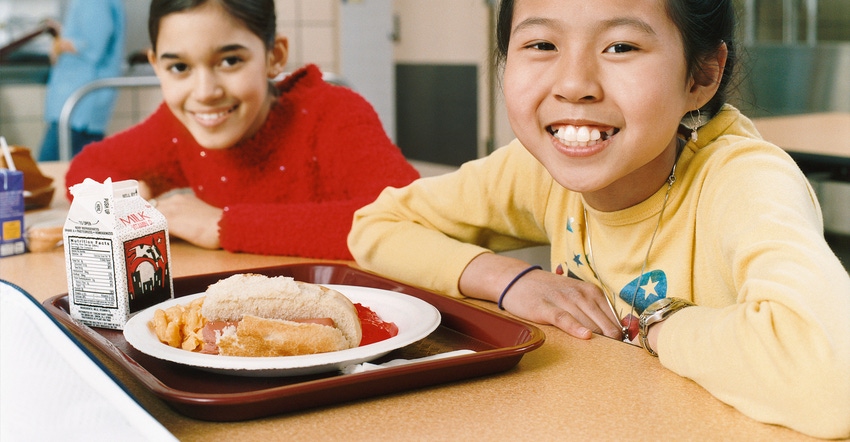May 3, 2018

Vermont schoolkids drank more than 750,000 gallons of milk in 2016, probably more in 2017. Most of it came from Vermont farms since the Green Mountain State produces 63% of New England's milk, according to a 2017 school survey.
But some school food service managers are looking for better source identification and want to serve milk with Vermont's name on it. One reason, they perceive, is that "local" milk is fresher.
Ali Zipparo, director of the Vermont Agency of Agriculture's Farm to School program, was amazed at the enthusiastic response from school food service agencies. Survey findings from the Milk Industry Report: Serving Vermont Schools were released in April. "They really want to know where their milk comes from," she says.
The biggest obstacle appears to be federal standards that schools have trouble meeting. USDA eliminated low-fat flavored milk from the National School Lunch program six years ago, and milk consumption dropped. Under current regulations, schools must serve 1% and non-fat milk. Only fat-free is now allowed for flavored milks – chocolate, maple, and strawberry. Revised standards will permit 1% flavored milk as of July 1.
"Fat content is a big issue, Zipparo says. "If we could sell full-fat milk in schools, it would be amazing. But our hands are tied by regulations favoring low-fat." And, milk consumption by school children impacts milk processors.
HP Hood sells more than 100,000 gallons of milk a year to Vermont schools in a variety of sizes, fat levels, and flavors. "If Vermont public schools begin offering students 1% flavored milk, and more school-aged children drink more milk, that would help Hood, other processors and dairy farmers," says Lynne Bohan, Hood's vice president of communications.
Other competing factors
Thomas Dairy, based in Rutland, Vt., sells milk to about 25 schools, down considerably since the dairy changed over its equipment to larger-sized plastic bottles in larger sizes. "We slowly but surely lost our school presence, so now we're trying to push bulk sales," says Abbey Thomas, part-owner of the business.
Her business could make 1% chocolate for schools. "For us to make a full batch to distribute, we need a demand of 40 bags. With the fresh quality, and shelf life being 16 to 18 days, it would be a huge risk to take for us to produce the product without guarantee of sale," she says.
Competing drinks also drag on school milk consumption. "Margins for soda, energy drinks, even water allow those manufacturers to offer equipment and incentives. Milk-bid businesses are won on a fraction of a penny," she says. "Dairy processors don't have the deep pockets that those other products have."
Bulk milk's problems
One of the first decisions Harley Sterling made as food service manager at Westminster Community Schools in Westminster, Vt., was to serve Vermont milk. Now, he offers Thomas Dairy in bulk. "Thomas milk is much fresher; it's a better product and the kids really like it," he says.
But the romance of serving "local" comes with hidden challenges. "Little kids drop their cups. There are five or six spills a day," Sterling says. "It makes teachers unsupportive. They don't see that its Thomas milk. They wonder, 'Why are my floors messy all the time?'"
Federal regulations require schools to serve a specific quantity of milk, making it difficult to serve bulk milk. Cups holding 8.3 ounces were a no-no. USDA says students aren't able to fill that size cup with 8 ounces of milk, so the school had to go to a larger size. "Now, we have to police how full they're filling those cups," Sterling says. "Then we have to wash them."
Paperboard cartons of 8-ounce milk are okay and cheaper to buy, but pose disposal issues. That's one reason Monument Farms of Weybridge, Vt., switched its bottling equipment to plastic bottles. Even so, bulk milk is the cheapest way to offer milk in schools, according to Monument Farm's Jon Rooney.
Suggestions from the report
The survey found little cost difference between cartons and bulk. But the final report noted that other research found bulk milk to be about 10 cents cheaper per 8-ounce serving, due to less waste and more consumption.
The report made these recommendations:
• Bulk milk suppliers should market the benefits of bulk distribution and help schools shift from cartons to bulk dispensers.
• Target sales of fat-compliant chocolate milk to schools already using bulk dispensers for white milk.
• Suppliers can help schools find money for new coolers through Vermont's Farm to School Equipment Grant program. Over the last four years, nearly $40,000 has gone to 39 schools for that purpose.
• Producers and suppliers should contact schools directly or through organizations to offer branded milk.
• Distributors could lease expensive bulk dispensers to schools.
Harlow writes from Westminster Station, Vt.
About the Author(s)
You May Also Like




